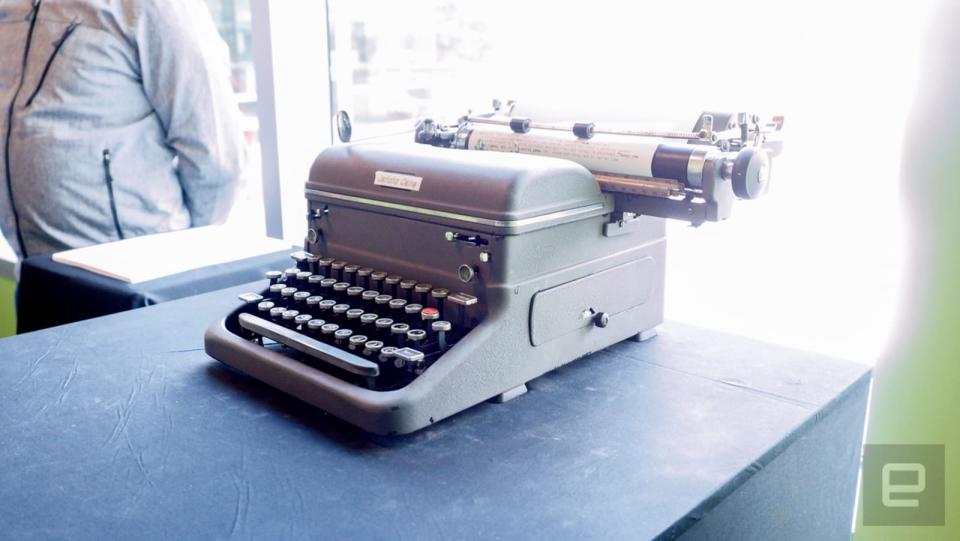Inside Mercedes' Silicon Valley research center
A tour of the automaker’s future, and sometimes weird, innovations.

A metal typewriter sits on a pedestal churning out the next sentence of a collaborative story. For every line I typed onto paper, the AI computer controlling the hunk of metal replies with what it thinks would be a good follow-up. The goal of the experiment is to see what happens when you feed an artificial intelligence only fairy tales. It's the kind of seemingly idiosyncratic thing you'd expect from IBM, Google or Apple. But I actually found it inside Mercedes-Benz's R&D North American headquarters in Silicon Valley. The German automaker is trying to see what happens when you let a computer learn how to write, space and spell on its own. The experiment could help researchers build an artificial brain for a car that could independently deduce and react to what's happening on the road. It might seem like these things are unrelated, but a typewriter cranking out sentences and a car automatically braking to miss an object in the road are both using the learn-and-react system of AI to get a job done. All that deep learning is one building blocks of autonomous systems. Another important aspect of self-driving cars is that the computers needed to keep them on the road not only have to learn and react but actually see what's going on. Most automakers use Lidar to scan the surrounding world with lasers to create a vast pixel map. The amount of data created by all those pinpoints is staggering. Mercedes thinks it's solved the problem of trying to crunch all that information by joining blocks of pixels to create single objects. So instead of an automobile trying to decipher 500,000 pixels, the car has to figure out the location of only 1,000 object-specific rectangles called "Stixels." Each Stixel can be a person, car or object and is assigned a color based on how close it is to the vehicle. Experiments like this are part of the company's new CASE (Connected, Autonomous Driving, Shared usage and Electric drive) strategy. Mercedes wants to build its own future instead of teaming up with a tech company. When you're beholden to another entity, you're stuck with whatever it decides to add to its platform. So Mercedes has its Silicon Valley facility working hard on a variety of initiatives. During a recent tour of the R&D headquarters, I saw the shiniest result of those initiatives and latest CASE project, the EQ concept vehicle it unveiled at the Paris Auto show. The electric car has autonomous features, replaced the dash with a giant display and shed all of its mirrors in favor of tiny cameras. While the vehicle looks like it's a prop from a reboot of Tron, it's actually the launching pad of the EQ line of vehicles and home-energy storage. Sadly, the concept vehicle on display will never appear in showrooms. Instead, it's a marketing tool for the launch of the EQ brand of vehicles and mobility initiatives that will start appearing in three years. It's a new category within Mercedes similar to Smart, its small-car subsidiary. But while the new business venture is a ways off, the automaker is already adding connected features to its current and upcoming lineup of Mercedes-Benz vehicles. It has an iOS and Apple Watch companion app for locking the doors. In the next year, it'll add Google Home support. Drivers will be able to interact with thesearch giant's Home assistant with the sound of their voice while driving. The integration will also learn a person's habits and will offer to turn on or off devices based on the car's location via AI. Don't worry if you're already part of the Alexa or HomeKit ecosystem — both of those platforms are being investigated. But it's not just the cars Mercedes sells to individuals that are being upgraded. The automaker is working on speeding up deliveries from services like UPS, FedEX and DHL. In a garage a few miles from the main building, a team of researchers is building a carpetlike covering for the shelves and floor of a delivery van that can weigh a package no matter where it is. I was initially unsure why the weight of each box was important. That was until they explained that the system can pinpoint the location of any item in the truck based on its mass and can have nearby LEDs light up when the driver needs to find said package. According to Mercedes, tests of the system with local delivery drivers have increased efficiency 35 percent. The drivers no longer have to hunt for a box that slid around the back of the truck during a sharp turn; the system just knows where everything is. It's research like this that could help the automaker maintain the pace needed to compete in the increasingly accelerating automotive tech landscape. It's a legacy brand that's seen cars changing quicker in the past few years than in the previous 90. It's done a good job keeping up, but pressure from Tesla, Google and established automakers means Mercedes has to be more nimble and think outside horsepower and tires. Even if it means experiments with mechanical typewriters and fairy tales.



























